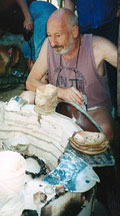The Work

Soldner was the first student admitted to the department that Voulkos had established in 1954 at the Los Angeles County Art Institute. In this inspiring program, Soldner learned to follow his own instincts about the possibilities for clay. This self-confidence, combined with his inventive mind, prepared Soldner for making discoveries that would change the course of Contemporary American ceramics. Soldner introduced American-style raku, a low-fire process, and, in so doing, helped to legitimize low-fired ware. Through his explorations of this technique, he has expanded the aesthetic possibilities for clay.
"The most difficult thing to teach is curiousity," Soldner says. "The next thing is the courage to do it." Having courage means taking risks, something that Soldner models in his class demonstrations. He throws pots off center or upside down, he also drops newly thrown pots on the floor to find in their crushed shapes fresh expressive possibilities.
Excerpts from "Soldner: the Teacher" by Mary Davis MacNaughton, and “Soldner: A Life in Art” by Elaine Levin, in Paul Solder: A Retrospective, 1991

